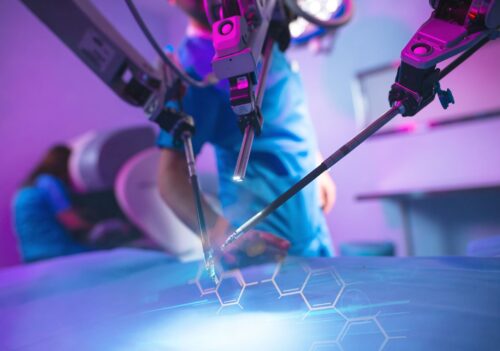Robotically assisted surgery is a relatively new technique which is on the rise, with 25% of hospital Trusts now offering robotically assisted surgery in varying different fields of medicine.
Broadly there are two types of surgical robot used; telemanipulators for soft tissue surgery and assistive guides for hard tissue (bone) surgery.
Robotics are being used increasingly in surgery and can be used in operations on the following areas:
- Joint replacement
- Prostate
- Gallbladder
- Kidney
- Gastric bypass
- Colorectal surgery
- Pancreas
- Hysterectomy
- Paediatric Surgery
- Heart valve replacement and bypass surgery
- Thyroid
- Transplant surgery
- Orthopaedic surgery
During the surgery, the surgeon will place and program the robot in order for it to carry out all or part of the surgery. Similar to a flight recorder or ‘black box’ in a plane, robotic surgical systems have a similar recording system. The system records the programming used and all details of the surgery in real time. This information is called metadata and can be very important when trying to understand if something has gone wrong.
Unlike surgeries conducted by hand where the surgeon makes a note after the fact, robotically assisted surgeries have a real-time record of events. This means that should the surgery go wrong, there should be a clear unbiased record of what occurred.
Whilst in general robotically assisted surgery is safe, with some data suggesting it is slightly safer than surgery by hand, there are still risks and potential for things to go wrong.
Negligence during robotic surgery sadly can and does happen. Issues that may arise are:
- Surgeon error in placing or engaging the robot
- Defective programming
- Equipment errors
- Manufacturing faults
- Hardware or Software errors
Negligence could occur where the surgeon inadequately programmed or operated the robot. This may occur as a result of lack of training, failure to follow the operative guide, or a lapse in concentration. Inadequate system and/or instrument checks prior to procedure may also result in errors occurring which could have otherwise been avoided. All of these can form the basis for a claim for damages.
Making a Clinical Negligence Claim
In the event that a robotically assisted surgery has been conducted negligently, patients are entitled to seek suitable compensation for their pain and suffering, and any follow up treatment or surgery required to rectify the error.
Our team has specialist expertise in understanding the nature and complexity of these claims and can deal with your matter in a professional and compassionate manner to secure the answers and compensation that you deserve.
If you have experienced problems with robotically assisted surgery which you think could have been caused by surgical negligence, call our team today on 0113 284 5000 or clinneg@isonharrison.co.uk


















